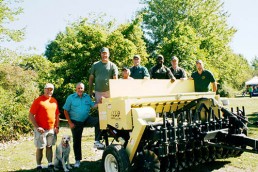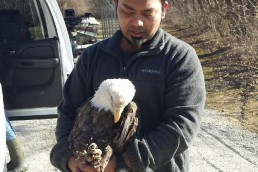NWTF Launches ‘Save the Habitat Save the Hunt’ Initiative
SHARE THIS POST
Is the future of turkey hunting in the Great Lakes states and throughout the nation in trouble? Declining numbers of turkey hunters, habitat loss and lack of hunter access is raising concern within the National Wild Turkey Federation (NWTF). However, rather than sit idle, they’ve decided to save our turkey-hunting lifestyle by launching a 10-year national initiative called “Save the Habitat. Save the Hunt.” This aggressive initiative is charged with several goals that will keep the future of turkeys and turkey hunting alive in Michigan and across the nation. According to NWTF Regional Biologist, Ryan Boyer whose territory covers Michigan and Indiana, “Save the Habitat. Save the Hunt” is the NWTF’s 10-year plan to conserve or enhance 4 million acres of upland habitat, create 1.5 million new hunters, and open access to 500,000 acres for hunting, shooting, and outdoor recreation.”
In an effort to complete these goals, the NWTF is committed to raising $1.2 billion through fundraising and their devoted volunteers. On the state level, the NWTF’s initiative will positively affect the wild turkeys in Michigan and create many improvements in multiple areas. According to Boyer, “As part of the 10-year national initiative, the NWTF in Michigan is determined to enhance or restore over 52,000 acres of upland habitat, help create 200,000 new hunters, and increase public access to 10,000 acres.”
Besides fundraising efforts, licenses purchased by hunters will also help with these conservation efforts. Boyer states, “License fees help pay for conservation. Since the inception of the license fee restructuring, hunters in Michigan who purchase a hunting license are helping fund habitat projects throughout the state through the State Wildlife Habitat Grant Program (SWHG). The awarded projects are focused on improving habitats of game species such as deer, wild turkey, grouse, waterfowl, etc. The NWTF was awarded funding from the Michigan DNR SWHG program for two projects in 2015, and will be working with the MI DNR and our conservation partners on future projects using dollars raised through the NWTF and the purchase of Michigan hunting licenses.”
These two SWHG funded habitat projects will take place inside of the Allegan State Game Area in Allegan County and the Gregory State Game Area in Livingston County. The anticipated completion of both projects will be in 2015. The first project consists of enhancing an imperiled oak savanna habitat. Boyer states, “We are mechanically treating and opening up oak savanna habitats to generate the growth of forbs and native grasses, which will enhance the hard mast production and increase the quality of the brood rearing, nesting, and roosting habitat for wild turkeys. Many other species will benefit from these enhancements including deer, grouse, woodcock, and the Federally Endangered Karner Blue Butterfly. We have a target goal of enhancing at least 176 acres in 2015.”
The second project occurring in the Gregory State Game Area will involve the enhancement of 122 acres of wildlife openings and diverse grasslands. According to Boyer, “These wildlife openings and grassland habitats have been slowly degrading and are being encroached by woody species. We are going to mechanically and chemically treat the woody species across 108 acres and plant an additional 14 acres into a diverse mix of native grasses, forbs and wildflowers. This project will enhance brood and nesting habitat as well as increase foraging opportunities vital to breeding hens and poults. Pheasants, songbirds, butterflies and a number of other game and nongame species will benefit from these enhancements.”
Another habitat project that has been worked on throughout the last few years by the NWTF in partnership with the United States Forest Service is the enhancement of 463 acres of oak savanna habitat inside of the Manistee National Forest. This will also be accomplished by using mechanical and hand treatments. This fall, approximately 387 acres of this area should be completed.
Numerous habitat projects are also occurring in the Upper Peninsula. According to NWTF Regional Biologist Rick Horton, whose area covers Minnesota, Wisconsin, Iowa and the UP, the following projects were completed in 2014: 317 acres of jack pine were harvested, 12 acres of aspen site prep, and 236 acres of jack pine site prep.
Are you enjoying this post?
You can be among the first to get the latest info on where to go, what to use and how to use it!
Horton states, “Turkey populations in the Western Peninsula are at the edge of their range and fluctuate with winter severity. This heavily forested landscape has little nesting and brood rearing cover. By maintaining young forests and wildlife openings we are improving turkeys’ ability to reproduce to grow the population or maintain it after severe winters.”
The NWTF has identified a total of four focal landscapes throughout Michigan, which they will concentrate their conservation efforts on. These areas affect the wild turkey the most. Boyer states, “These focused efforts will allow the NWTF to have the greatest impact on wild turkey populations across the state while optimizing the use of our members’ dollars. Achieving these goals is only possible with the help of our hard-working volunteers and members and through critical conservation partnerships.”
The NWTF plans on accomplishing their second goal of creating 1.5 million new hunters through an R3 approach, which includes hunter recruitment, hunter retention, and hunter re-activation. Boyer states, “We need to introduce hunting to new audiences, but more importantly, we need to retain those individuals. In some cases, we need to re-activate those individuals that used to hunt but no longer do.”
A variety of programs exist that aim at creating opportunities for individuals to get outdoors and turkey hunt. These include NWTF’s Jakes, Women in the Outdoors and the Wheelin’ Sportsmen Program. The NWTF also plans on using education to help with hunter recruitment. Boyer explains, “Lastly, we want to educate the public on the North American Model of Conservation and the impacts that hunting has in Michigan and across the U.S. One of the top reasons people don’t hunt is due to a lack of understanding of the impacts that hunting has on wildlife populations, people, conservation and the economy.”
The last goal of increasing hunter access was outlined within the Michigan State Strategic Plan to Save the Habitat Save the Hunt. This will be accomplished by helping the DNR identify lands to include in their Hunter Access Program, working with government agencies and NGOs to partner in the acquisition of properties to become available for public hunting, and serving as an advocate for increasing public access to areas that are currently closed to hunting. According to Horton, in 2014, 233.6 acres of openings and trails were mowed and hand cut, which included 25.75 miles of a hunter-walking trail inside of the Ottawa National Forest in the Upper Peninsula. This will greatly improve hunter access along with habitat for wild turkeys.
If you’re like me you may be asking yourself, “How can I help with the ‘Save the Habitat. Save the Hunt.’ initiative? According to Boyer, “Turkey hunters along with anyone concerned about the future of conservation and hunting are encouraged to join the NWTF and to get involved with one of the local chapters throughout the state. For more information on the benefits of being an NWTF member and how to become involved in Save the Habitat/Save the Hunt in your area, go to nwtf.org/michigan.
Did you enjoy this post?
You can be among the first to get the latest info on where to go, what to use and how to use it!
Darin Potter
Darin Potter’s passion for outdoor writing began at the age of 12 when he first began writing in a journal that his parents bought him on a family camping trip in Northern Michigan. His writings have appeared in several Midwest publications: Michigan-Out-of-Doors, Michigan and Ohio Outdoor News, Modern Pioneer, and MidWest Outdoors.

